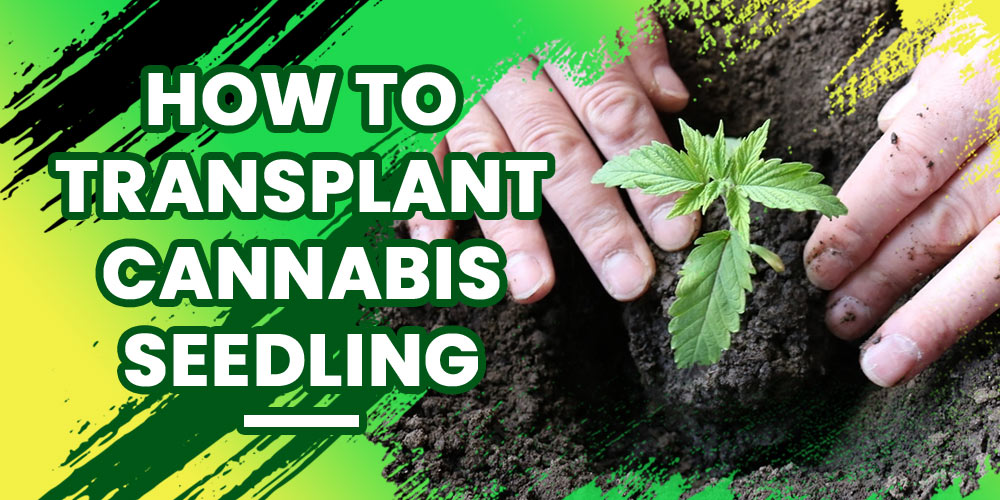


The world of cannabis cultivation has experienced tremendous growth over the years, spurred on by the increasing demand for both recreational and medicinal use. Among the critical steps in cannabis cultivation is the process of how transplanting cannabis seedlings. This entails moving a plant from one container to another, accompanied by fresh soil. This vital step plays an indispensable role in the growth and development of cannabis plants, making it crucial to understand the importance and benefits of transplanting cannabis seedlings for healthy and robust plant growth.
Transplanting cannabis seedlings is essential for achieving optimal growth and development of the plant. Seedlings require specific environments to grow and develop roots, and transplanting cannabis at the right time ensures they have enough space and nutrients to thrive. By transplanting cannabis, overcrowding and competition for resources are minimized, which can significantly affect plant growth negatively. Additionally, moving seedlings into a larger pot allows their roots to spread out, enabling the plant to absorb more water and nutrients from the soil, thus bolstering its overall health and vitality.
A. Choosing the right container:
Choosing the right container is crucial for successful cannabis seedling transplantation. The container should be appropriate in size and material to provide enough space for the seedling to grow and allow proper drainage to prevent waterlogging. The container’s material should also be breathable to allow adequate airflow to the roots and prevent root rot.
B. Preparing the soil or growing medium:
Preparing the soil or growing medium is another essential aspect of transplanting cannabis. The soil or growing medium should be rich in nutrients and well-draining to prevent waterlogging, which can cause root rot. The pH level of the soil should be between 6.0 and 7.0 to ensure optimal nutrient uptake. Growers can add compost, perlite, or vermiculite to the soil to increase its nutrient content and improve drainage.
C. Transplanting at the right time:
Transplanting cannabis seedlings at the right time is crucial for their growth and development. The ideal time for transplantation is when the seedlings have developed strong roots and have two to three sets of leaves. Transplanting seedlings too early or too late can lead to stunted growth, as the seedling may not have enough root development to absorb water and nutrients.
D. Watering and feeding seedlings before transplanting:
Watering and nourishing tender seedlings prior to transplanting cannabis is crucial for their robust growth and optimal development. Adequate moisture is essential for the growth of robust roots, however, overwatering can lead to the harmful effects of waterlogging and root rot. It is imperative to regulate watering practices to maintain soil moisture at an optimal level. Additionally, providing seedlings with a balanced fertilizer can effectively enhance their healthy growth and development. It is recommended to adhere to the prescribed dosage and frequency of fertilizer application to avoid the detrimental effects of a nutrient burn, which could potentially harm the seedlings.
So once you have prepared all the necessary things before transplanting cannabis, now we can go to the real deal. And here, we provide you with a step-by-step guide to transplanting your cannabis seedlings.
Fill the container with the prepared soil, leaving enough space to accommodate the seedling’s root ball.
Dig a hole in the center of the soil, large enough to accommodate the seedling’s root ball.
Carefully remove the seedling from its previous container, taking care not to damage the roots.
Place the seedling in the hole, ensuring the root ball is covered with soil.
Water the seedling gently, making sure not to overwater it. The soil should be moist but not waterlogged.
Place the container in an area with adequate light and provide nutrients as needed to promote healthy growth.
Monitor the seedling for the first few days to ensure it is adjusting well to its new environment. Adjust watering or nutrient levels as needed if the seedling shows any signs of stress, such as wilting.
After transplanting cannabis seedlings, some common problems that growers may encounter include transplant shock, overwatering, under-watering, and nutrient deficiency. Here are some possible solutions to these problems:
Transplant shock: The process of transplantation may trigger a phenomenon known as transplant shock, which can result in unsightly symptoms such as drooping, yellowing foliage, and sluggish growth. To mitigate these adverse effects, it is essential to provide the seedlings with a stable and stress-free environment. This can be accomplished by relocating the seedlings to a shaded area, minimizing water and nutrient intake, and abstaining from any physical disturbance.
Overwatering: Overwatering can cause waterlogging, which can lead to root rot, wilting, and yellowing leaves. The solution is to reduce the watering frequency and allow the soil to dry out slightly before watering again. Good drainage and a well-ventilated environment can also prevent overwatering.
Underwatering: Insufficient watering can lead to a cascade of symptoms, including drooping, yellowing foliage, and stunted growth. The remedy for this issue is to augment watering frequency and ensure that the soil maintains an adequate level of moisture while preventing overwatering. The inclusion of mulch or moisture-retaining substances in the soil can aid in retaining moisture and preventing rapid evaporation.
Nutrient deficiency: Inadequate nutrient supply can be the underlying cause of undesirable symptoms such as yellowing foliage, lackluster growth, and impaired bud development. The optimal solution is to supplement the seedlings with the essential nutrients they require, either through the use of fertilizers or organic amendments. Furthermore, achieving the optimal pH range of 6.0-7.0 through pH adjustment can promote efficient nutrient uptake and utilization.
It is essential to identify and address any problems promptly to ensure that the seedling develops into a healthy and robust plant. Monitoring the seedling’s growth regularly and adjusting environmental factors as needed can prevent common problems after transplantation.
In summary, transplanting cannabis seedlings is a crucial step in the growing process that requires careful consideration of factors such as container selection, soil preparation, and timing. Common problems such as transplant shock, overwatering, underwatering, and nutrient deficiency can be addressed by adjusting environmental factors and providing the seedling with the necessary nutrients. And if you want reliable seeds that will germinate 80% of the time you should try buying from Crop King Seeds. Crop King Seeds offer premium quality seeds and has a variety of choices to choose from.



Best Selling
Feminized Seeds
Regular Seeds
Customer Help
WE SELL MARIJUANA SEEDS IN THE USA
Best Selling
Feminized Seeds
Regular Seeds
Autoflowering
Customer Help
WE SELL MARIJUANA SEEDS IN THE USA